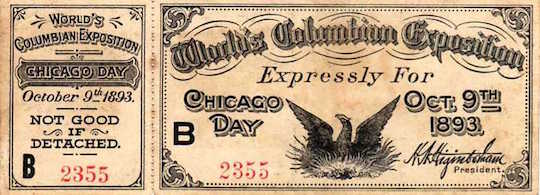World's Columbian Exposition, 1893
Your Entry Ticket

Scenes from the White City

Scenes from a tenement
How the other half lives, chapter one
by Lindsay Noseworthy, Master of Arms
By means of introduction, I am Lindsay Noseworthy, your second-in-charge. I do apologize for the young Mr. Suckling and his informality of speech. Demerits will be disbursed.
Our first site is the Windy City, which derives its nom de plum not from the gusts that roll off Lake Michigan but rather the loquaciousness of its politicians. I would be remiss in failing to mention that the year is 1893, as the Inconvenience is a bit of a time machine as well. We’ve arrived in the middle of the Columbian Exposition celebrating the 400th anniversary of Columbus’ arrival in America. But truth be told, the event is about celebrating the arrival of America itself.
Behold the Beaux-Arts beauty of the buildings of the White City, as well as its state of the art sanitation facilities, AC powered street lighting and the countless exhibits contained within celebrating American culture and ingenuity. You are witnessing the birth of modern city planning. Behold the many firsts: Ferris’ spinning wheel, the moving sidewalk, and yes, motion pictures. Over to your right we’ve even set you up with your own kinetoscope of sorts. Just hit play.
Before the end of its six-month run, an estimated one quarter of the US population will have experienced the Exposition. Admittedly, many of them seeking out the more common variety of wonders available on the Midway Plaisance, including the culinary innovations of what you've come to know as hamburgers, soda and Cracker Jacks.
Alas, as we glide over the city itself, the promise of the future gives way to actual turn of the century urban reality. I do apologize for the smell and I would warn those with lesser constitutions to brace themselves for the brutality of the Stockyards and the general squalor that permeates this turn of the century urban scene. We’ve cued up the first chapter of How the Other Half Lives for your edification as well. Mr. Pynchon lands us squarely in the middle of this dichotomy of urban promise and both physical and moral decay with his challenging novel, Against the Day.
Um, now I fear I must bade you a hasty adieu, as it appears Miles has got himself tangled up in the rigging causing the main valve to open and ushering our sudden and rather rapid descent. I do sincerely hope you enjoy the rest of the tour -- what little perhaps there may be left of it.
